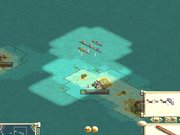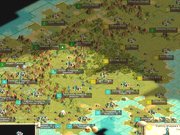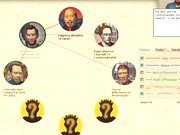Civilization III: Conquests Preview
We get a close-up look at the Civilization III expansion that will add nine major scenarios and many game enhancements.
Few games have been as influential as Sid Meier's Civilization (1991), which defined a new brand of strategy game covering an empire's technological, diplomatic, economic, and military endeavors over a huge expanse of time with very elegant gameplay that was easy to get into and keep playing, turn after turn. Civilization III marked a major update for the series, introducing new mechanics like culture, great leaders, and tradable resources, but the massive scale of the game remained the same. That's just what the upcoming expansion pack, Civilization III: Conquests, will change, with nine detailed "conquests," or scenarios, that zoom in on a specific moment in history. These scenarios can be nearly as involved as the main Civilization game with their own tech trees, additional civilizations, and unique units. Conquests also introduces a number of general gameplay enhancements that carry over to the core game and to the improved multiplayer modes.

Firaxis and Breakaway Games have been working together on the expansion pack, and it's been in full production since January, not long after the release of last year's Play the World multiplayer-focused add-on. Yet the most involved of the scenarios, the Sengoku conquest set in feudal Japan, has been a Firaxis designer's personal project for more than a year. What makes the nine scenarios genuinely impressive is just how much the game is customized for each setting. The conquests are also designed to suit a variety of play styles, with some focused on culture or wonder victories, while others are about constant fighting over victory locations.
The scenarios are generally like compressed versions of the main game, and this has allowed the designers to put much more specific historical detail into each one. While the main game has long included anachronisms for gameplay reasons--like having the United States as a playable civilization starting in 4000 BC--much effort has gone into making even small details like World War II ship names authentic. The very earliest scenario appropriately takes place in ancient Mesopotamia and includes civilizations like the Babylonians and the Phoenicians, which aren't found in the main game. The scenario maps have been handcrafted to represent regional geography in some detail, and civilizations are placed in their historical locations. Although most players hurry through the ancient age in the main game to get to bigger and better things, the Mesopotamian episode has plenty of additions and balanced changes to create a real sense of progression from the Bronze Age to the Iron Age, with new structures (including the early factories, worker housing, and alchemist workshop), new technologies (like epic work projects), and government types like tribal council. Even though it's about a race to build the seven wonders of the world, there's plenty of reason to expand and build your empire to be the most powerful in the ancient world. In fact, it's essential to expand to control enough of the stone resource necessary to build wonders.

Another of the four episodes available in the preview version we played is a culture-focused scenario set in Mesoamerica. However, in the world of Aztecs, Incas, and Mayas, there's a new twist on how you can increase your cultural influence: ritual sacrifice. One of the additions to the game is the ability to capture enemy units, which are enslaved as workers and can be sacrificed if you choose. Seeing other nations' natives killed in public creates some amount of discontent among your citizens, but naturally if you run out of slaves to sacrifice and decide--in a desperate push toward victory--to send your own people to the altar, the discontent grows dramatically. The Mesoamerican map is also a good place to spot one of the new map features--volcanoes. They're easy to spot and can provide extra resources, but they will periodically blow their tops and wreak destruction, destroying units and cities within several tiles in a random direction.
Civ Warfare on a Massive Scale
The Mesoamerican map is host to a bunch of new strategic resources, including exotic birds, maize, and llamas, which can make your people happier as luxuries or are required to build certain units. There are also some new units, such as the chasqui scout, which is well adapted to the local jungles and mountains and able to move quickly through any terrain. The silent hunter is one example of a unit with the new stealth attack ability, which a number of units in the scenarios and in the main game can use to attack any unit in a group. In the modern age, this means that some aircraft can carry out precision bombing.

The most complex of the scenarios, entitled Sengoku - Sword of the Shogun, features a total of 18 competing clans and can last a whopping 540 turns. One of its unusual features is that you have a king unit, the daimyo, that has a few special abilities and can be upgraded 10 levels as you go up the tech tree, but, like in the regicide game mode, his death means losing the game. The other 17 computer-controlled clans are set at very high levels of aggression, so it won't be easy to unite the clans as shogun and win a diplomatic victory, which requires you to build the war council wonder and have exceedingly good relations with all the clans. To help out in the constant warring, there are many technology advances focused on developing new units, including muskets discovered by contact with the Portuguese and ninja that are invisible and can attack without enemies knowing their nationality. To counter such ninja strikes, there are sokei warrior monks that can detect invisible units and that also have a good defense rating of 5, though this still won't hold back the powerful samurai arquebusiers at the top of the tech tree (attack rating of 10, defense rating of 8). This is a good example of how units are balanced within each scenario, without disturbing the core game.
The scenarios in Conquests are equally distributed throughout Civilization's 6000-year timeline, and WWII in the Pacific will provide a thorough dose of warfare in the modern era. By the time most people reach the main game's modern era, the game's outcome has often been decided. So here's your chance to dive into the momentous engagements following Japan's attack on Pearl Harbor. To re-create that surprise attack's effects, Japan is the only side to move in the first turn, and once the turn starts, you'll sit through several minutes of frantic bombing and amphibious invasions. The challenge for the Japanese side is to aggressively capture and hold victory locations early, before the US side can reinforce Hawaii, Wake Island, and other Pacific territories with ships, tanks, and marines produced in the populous West Coast cities. The scenario promises to be as action-oriented as any game of Civilization can get, but it does certainly take some effort right at the start to set the huge number of military units in motion. And although it's mostly a military slugfest, the scenario does offer each side (China, the Commonwealth, and the Netherlands are also playable and are in a locked alliance with the US) some very useful discoveries to research, notably kamikaze bombers and the atomic bomb.

The new single-player scenarios represent a lot of new content, but that's not all Conquests has to offer. There are seven new playable civilizations, and with the addition of two new civilization types, agricultural and seafaring, all of them have been rebalanced to have two types that affect their abilities. Expert players will face new challenges with the two new difficulty levels, demigod and "Sid." Interface improvements include the ability to rally the production of all cities to a certain location and the ability to quickly toggle governor settings and messages. Firaxis has also reworked many of the unique units to make them more useful, has added scientific great leaders that can appear each time you are first to discover a technology, and has added back two government types from Civilization II, fascism and feudalism. Conquests will also include all of the content and features from the Play the World expansion, but multiplayer games will be kept separate because of the very different game balance. Civilization III: Conquests is currently in beta testing and is scheduled for release in late October.
Got a news tip or want to contact us directly? Email news@gamespot.com
Join the conversation